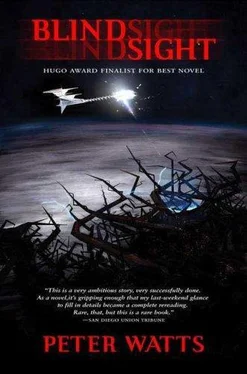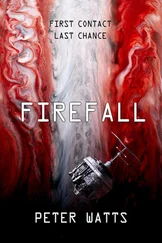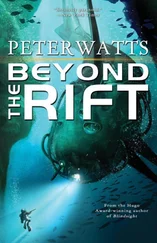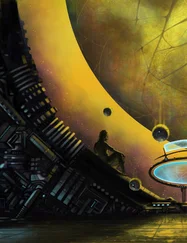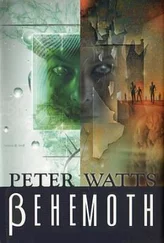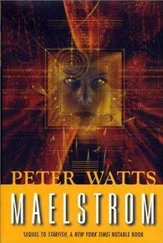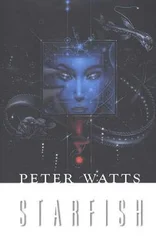I tweaked my jets. Sascha hesitated. Coils of shielded cable floated about us like umbilical cords.
“ Now ,” Bates said, plugging a feed from her own suit directly into the offlined grunt.
Sascha started after me. Bates took up the rear. I watched my HUD; a swarm of multiarmed monsters would appear there any moment.
They didn’t. But the blackened thing against the belly of Bates’ machine was real enough. Not a hallucination. Not even some understandable artefact of fear and synesthesia. Rorschach was inhabited. Its inhabitants were invisible.
Sometimes. Sort of.
And, oh yeah. We’d just killed one.
* * *
Bates threw the deactivated grunt into the sky as soon as we’d made vacuum. Its comrades used it for target practice while we strapped in, firing and firing until there was nothing left but cooling vapor. Rorschach spun even that faint plasma into filigree before it faded.
Halfway back to Theseus , Sascha turned to the Major: “You—”
“No.”
“But — they do shit on their own, right? Autonomous.”
“Not when they’re slaved.”
“Malfunction? Spike?”
Bates didn’t answer.
She called ahead. By the time we made it back Cunningham had grown another little tumor on Theseus ’ spine, a remote surgery packed with teleops and sensors. One of the surviving grunts grabbed the carcass and jumped ship as soon as we passed beneath the carapace, completing the delivery as we docked.
We were born again to the fruits of a preliminary necropsy. The holographic ghost of the dissected alien rose from ConSensus like some flayed and horrific feast. Its splayed arms looked like human spinal columns. We sat around the table and waited for someone else to take the first bite.
“Did you have to shoot it with microwaves ?” Cunningham sniped, tapping the table. “You completely cooked the animal. Every cell was blown out from the inside.”
Bates shook her head. “There was a malfunction.”
He gave her a sour look. “A malfunction that just happens to involve precise targeting of a moving object. It doesn’t sound random to me.”
Bates looked back evenly. “Something flipped autonomous targeting from off to on . A coin toss. Random.”
“Random is—”
“Give it a rest, Cunningham. I don’t need this shit from you right now.”
His eyes rolled in that smooth dead face, focused suddenly on something overhead. I followed his gaze: Sarasti stared down at us like an owl panning for meadow voles, drifting slowly in the Coriolis breeze.
No visor this time, either. I knew he hadn’t lost it.
He fixed Cunningham. “Your findings.”
Cunningham swallowed. Bits and pieces of alien anatomy flickered with color-coded highlights as he tapped his fingers. “Right, then. I’m afraid I can’t give you much at the cellular level. There’s not much left inside the membranes. Not many membranes left, for that matter. In terms of gross morphology, the specimen’s dorsoventrally compressed and radially symmetrical, as you can see. Calcareous exoskeleton, keratinised plastic cuticle. Nothing special.”
Bates looked skeptical. “ Plastic skin is ‘nothing special’?”
“Given the environment I was half-expecting a Sanduloviciu plasma. Plastic’s simply refined petroleum. Organocarbon. This thing is carbon-based. It’s even protein based, although its proteins are a great deal tougher than ours. Numerous sulphur cross-bonds for lateral bracing, as far as I could tell from what your grunts didn’t denature.” Cunningham’s eyes looked past us all; his consciousness was obviously far aft, haunting remote sensors. “The thing’s tissues are saturated with magnetite. On earth you find that material in dolphin brains, migratory birds, even some bacteria — anything that navigates or orients using magnetic fields. Moving up to macrostructures we’ve got a pneumatic internal skeleton, which as far as I can tell doubles as musculature. Contractile tissue squeezes gas through a system of bladders that stiffen or relax each segment in the arms.”
The light came back into Cunningham’s eyes long enough to focus on his cigarette. He brought it to his mouth, dragged deeply, set it down again. “Note the invaginations around the base of each arm.” Flaccid balloons glowed orange on the virtual carcass. “ Cloacae , you could call them. Everything opens into them: they eat, breathe, and defecate through the same little compartment. No other major orifices.”
The Gang made a face that said Sascha, grossed out . “Don’t things get — clogged up? Seems inefficient.”
“If one gets plugged, there’s eight other doors into the same system. You’ll wish you were so inefficient the next time you choke on a chicken bone.”
“What does it eat?” Bates asked.
“I couldn’t say. I found gizzard-like contractiles around the cloacae, which implies they chew on something, or did at some point in their history. Other than that…” He spread his hands; the cigarette left faint streamers in its wake. “Inflate those contractiles enough and you create an airtight seal, by the way. In conjunction with the cuticle, that would allow this organism to survive briefly in vacuum. And we already know it can handle the ambient radiation, although don’t ask me how. Whatever it uses for genes must be a great deal tougher than ours.”
“So it can survive in space,” Bates mused.
“In the sense that a dolphin survives underwater. Limited time only.”
“How long?”
“I’m not certain.”
“Central nervous system,” Sarasti said.
Bates and the Gang grew suddenly, subtly still. James’s affect seeped out over her body, supplanting Sascha’s.
Smoke curled from Cunningham’s mouth and nose. “There’s nothing central about it, as it transpires. No cephalisation, not even clustered sense organs. The body’s covered with something like eyespots, or chromatophores, or both. There are setae everywhere. And as far as I can tell — if all those little cooked filaments I’ve been able to put back together after your malfunction really are nerves and not something completely different — every one of those structures is under independent control.”
Bates sat up straight. “Seriously?”
He nodded. “It would be akin to independently controlling the movement of each individual hair on your head, although this creature is covered with little hairs from tip to tip. The same thing applies to the eyes. Hundreds of thousands of eyes, all over the cuticle. Each one is barely more than a pinhole camera, but each is capable of independent focus and I’m guessing all the different inputs integrate somewhere up the line. The entire body acts like a single diffuse retina. In theory that gives it enormous visual acuity.”
“A distributed telescope array,” Bates murmured.
“A chromatophore underlies each eye — the pigment’s some kind of cryptochrome so it’s probably involved in vision, but it can also diffuse or contract through the local tissue. That implies dynamic pigment patterns, like a squid or a chameleon.”
“Background pattern-matching?” Bates asked. “Would that explain why Siri couldn’t see it?”
Cunningham opened a new window and played grainy looped imagery of Siri Keeton and his unseen dance partner. The creature I hadn’t noticed was ominously solid to the cameras: a floating discoid twice as wide as my own torso, arms extending from its edges like thick knotted ropes. Patterns rippled across its surface in waves; sunlight and shadow playing on a shallow seabed.
“As you can see, the background doesn’t match the pattern,” Cunningham said. “It’s not even close.”
Читать дальше
